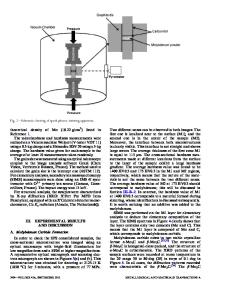Spark Plasma Sintering of Materials Advances in Processing and Appli
This book describes spark plasma sintering (SPS) in depth. It addresses fundamentals and material-specific considerations, techniques, and applications across a broad spectrum of materials. The book highlights methods used to consolidate metallic or ceram
- PDF / 34,785,358 Bytes
- 767 Pages / 439.43 x 683.15 pts Page_size
- 19 Downloads / 350 Views
Spark Plasma Sintering of Materials
Advances in Processing and Applications
Spark Plasma Sintering of Materials
Pasquale Cavaliere Editor
Spark Plasma Sintering of Materials Advances in Processing and Applications
Editor Pasquale Cavaliere Department of Innovation Engineering University of Salento Lecce, Italy
ISBN 978-3-030-05326-0 ISBN 978-3-030-05327-7 https://doi.org/10.1007/978-3-030-05327-7
(eBook)
Library of Congress Control Number: 2019932159 © Springer Nature Switzerland AG 2019 This work is subject to copyright. All rights are reserved by the Publisher, whether the whole or part of the material is concerned, specifically the rights of translation, reprinting, reuse of illustrations, recitation, broadcasting, reproduction on microfilms or in any other physical way, and transmission or information storage and retrieval, electronic adaptation, computer software, or by similar or dissimilar methodology now known or hereafter developed. The use of general descriptive names, registered names, trademarks, service marks, etc. in this publication does not imply, even in the absence of a specific statement, that such names are exempt from the relevant protective laws and regulations and therefore free for general use. The publisher, the authors, and the editors are safe to assume that the advice and information in this book are believed to be true and accurate at the date of publication. Neither the publisher nor the authors or the editors give a warranty, express or implied, with respect to the material contained herein or for any errors or omissions that may have been made. The publisher remains neutral with regard to jurisdictional claims in published maps and institutional affiliations. This Springer imprint is published by the registered company Springer Nature Switzerland AG The registered company address is: Gewerbestrasse 11, 6330 Cham, Switzerland
Preface
From the two last decades, elaboration techniques based on the use of high current intensities, among which the SPS technique is probably the most popular, have attracted considerable interest. Spark plasma sintering (SPS) is the process of consolidating powder (metallic or ceramic) constrained in a die (most often graphite) through the application of large amounts of pulsed DC electrical current. Unlike conventional sintering, the SPS process affords rapid heating rates and reduced sintering temperatures that suppress microstructural coarsening. It has been demonstrated that the surface oxides at interparticle contact points can be mitigated by SPS. The SPS method has recently made significant advancements in materials science and materials processing thanks to its capability of fast and efficient densification of a great variety of materials and the suitability of the equipment for conducting solid-state syntheses and syntheses, in which liquid phases can form within limited volumes locally at the contacts between particles. Spark plasma sintering (SPS) has garnered considerable attention for its ability to retain nanocrystalline microstructures a











